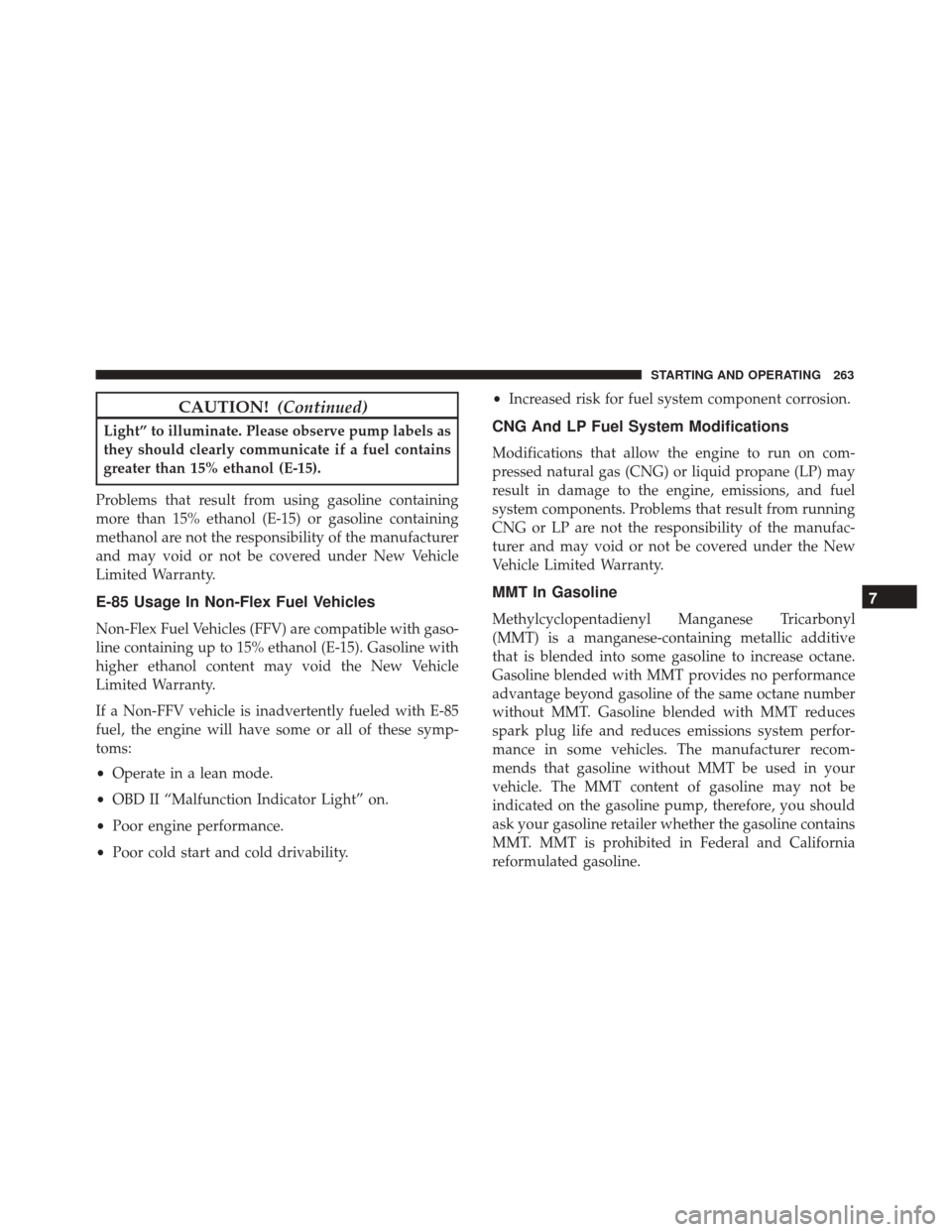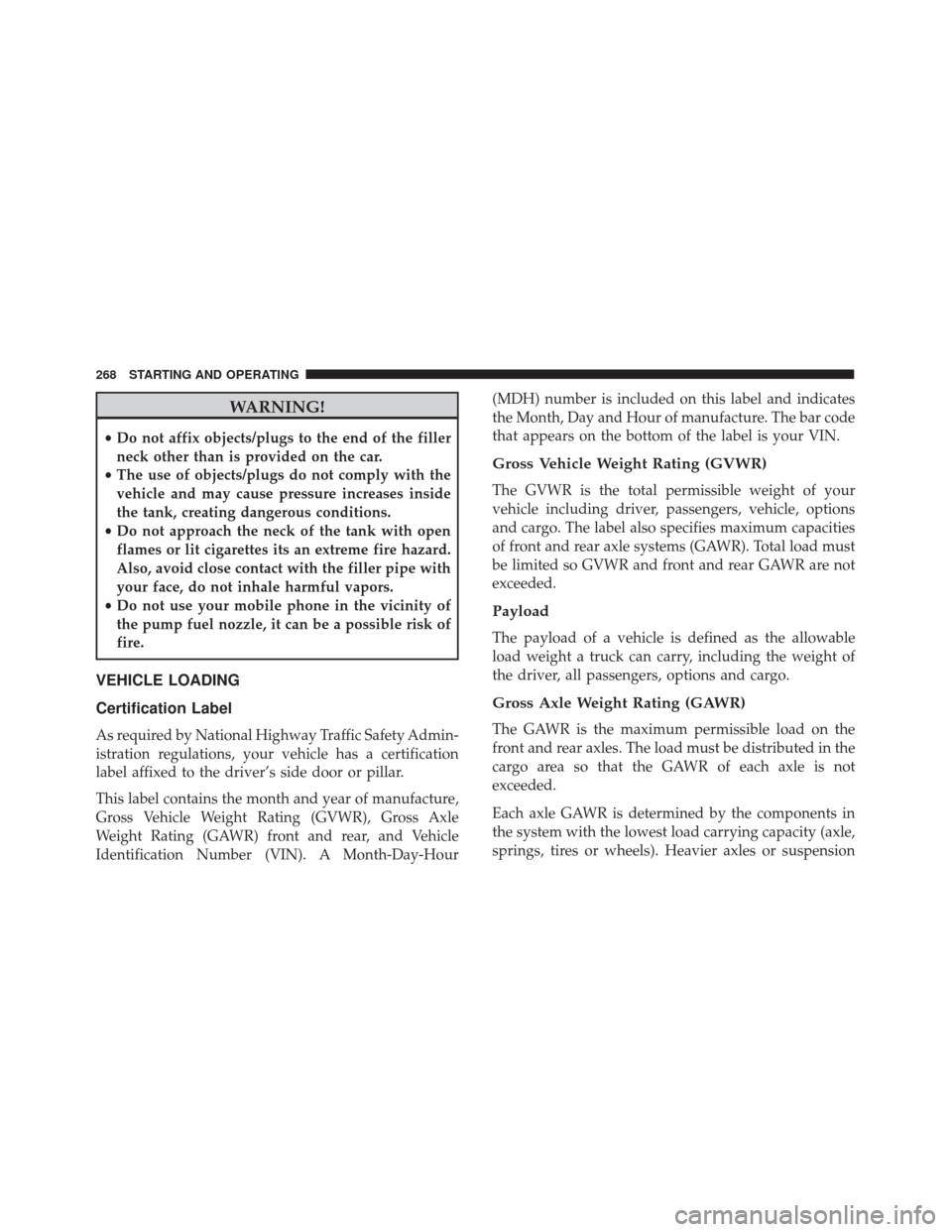Page 187 of 476

Enhanced Accident Response System
In the event of an impact, if the communication net-
work remains intact, and the power remains intact,
depending on the nature of the event, the ORC will
determine whether to have the Enhanced Accident
Response System perform the following functions:
•Cut off fuel to the engine.
• Flash hazard lights as long as the battery has power
or until the hazard light button is pressed. The
hazard lights can be deactivated by pressing the
hazard light button.
• Turn on the interior lights, which remain on as long
as the battery has power or for 15 minutes from the
intervention of the Enhanced Accident Response
System.
• Unlock the power door locks.
• Turn off the Fuel Pump Heater (if equipped).
• Turn off the HVAC Blower Motor.
• Close the HVAC Circulation Door.
Enhanced Accident Response System Reset
Procedure
After the event occurs, when the system is active, a
message regarding fuel cutoff is displayed. Turn the
ignition switch from ignition AVV/START or MAR/
ACC/ON/RUN to ignition STOP/OFF/LOCK. Care-
fully check the vehicle for fuel leaks in the engine
compartment and on the ground near the engine com-
partment and fuel tank before resetting the system and
starting the engine.
Depending on the nature of the event the left and right
turn signal lights, located in the instrument panel, may
both be blinking and will continue to blink. In order to
move your vehicle to the side of the road, you must
follow the system reset procedure.
6
SAFETY 185
Page 265 of 476

CAUTION!(Continued)
Light” to illuminate. Please observe pump labels as
they should clearly communicate if a fuel contains
greater than 15% ethanol (E-15).
Problems that result from using gasoline containing
more than 15% ethanol (E-15) or gasoline containing
methanol are not the responsibility of the manufacturer
and may void or not be covered under New Vehicle
Limited Warranty.
E-85 Usage In Non-Flex Fuel Vehicles
Non-Flex Fuel Vehicles (FFV) are compatible with gaso-
line containing up to 15% ethanol (E-15). Gasoline with
higher ethanol content may void the New Vehicle
Limited Warranty.
If a Non-FFV vehicle is inadvertently fueled with E-85
fuel, the engine will have some or all of these symp-
toms:
• Operate in a lean mode.
• OBD II “Malfunction Indicator Light” on.
• Poor engine performance.
• Poor cold start and cold drivability. •
Increased risk for fuel system component corrosion.
CNG And LP Fuel System Modifications
Modifications that allow the engine to run on com-
pressed natural gas (CNG) or liquid propane (LP) may
result in damage to the engine, emissions, and fuel
system components. Problems that result from running
CNG or LP are not the responsibility of the manufac-
turer and may void or not be covered under the New
Vehicle Limited Warranty.
MMT In Gasoline
Methylcyclopentadienyl Manganese Tricarbonyl
(MMT) is a manganese-containing metallic additive
that is blended into some gasoline to increase octane.
Gasoline blended with MMT provides no performance
advantage beyond gasoline of the same octane number
without MMT. Gasoline blended with MMT reduces
spark plug life and reduces emissions system perfor-
mance in some vehicles. The manufacturer recom-
mends that gasoline without MMT be used in your
vehicle. The MMT content of gasoline may not be
indicated on the gasoline pump, therefore, you should
ask your gasoline retailer whether the gasoline contains
MMT. MMT is prohibited in Federal and California
reformulated gasoline.
7
STARTING AND OPERATING 263
Page 270 of 476

WARNING!
•Do not affix objects/plugs to the end of the filler
neck other than is provided on the car.
• The use of objects/plugs do not comply with the
vehicle and may cause pressure increases inside
the tank, creating dangerous conditions.
• Do not approach the neck of the tank with open
flames or lit cigarettes its an extreme fire hazard.
Also, avoid close contact with the filler pipe with
your face, do not inhale harmful vapors.
• Do not use your mobile phone in the vicinity of
the pump fuel nozzle, it can be a possible risk of
fire.
VEHICLE LOADING
Certification Label
As required by National Highway Traffic Safety Admin-
istration regulations, your vehicle has a certification
label affixed to the driver’s side door or pillar.
This label contains the month and year of manufacture,
Gross Vehicle Weight Rating (GVWR), Gross Axle
Weight Rating (GAWR) front and rear, and Vehicle
Identification Number (VIN). A Month-Day-Hour (MDH) number is included on this label and indicates
the Month, Day and Hour of manufacture. The bar code
that appears on the bottom of the label is your VIN.
Gross Vehicle Weight Rating (GVWR)
The GVWR is the total permissible weight of your
vehicle including driver, passengers, vehicle, options
and cargo. The label also specifies maximum capacities
of front and rear axle systems (GAWR). Total load must
be limited so GVWR and front and rear GAWR are not
exceeded.
Payload
The payload of a vehicle is defined as the allowable
load weight a truck can carry, including the weight of
the driver, all passengers, options and cargo.
Gross Axle Weight Rating (GAWR)
The GAWR is the maximum permissible load on the
front and rear axles. The load must be distributed in the
cargo area so that the GAWR of each axle is not
exceeded.
Each axle GAWR is determined by the components in
the system with the lowest load carrying capacity (axle,
springs, tires or wheels). Heavier axles or suspension
268 STARTING AND OPERATING
Page 312 of 476
CavityMaxi Fuse Cartage Fuse Mini Fuse Description
F16 ––5 Amp Tan Engine Control
Module Power, Au-tomatic Transmis- sion
F17 ––10 Amp Red
15 Amp Blue Supply Primary
Loads (1.4L)
Supply Primary Loads (2.4L)
F18 ––30 Amp Green Power All-Wheel
Drive
F19 ––7.5 Amp Brown Air Conditioner
Compressor
F20 ––5 Amp Tan Electronic Power
Four-Wheel Drive
F21 ––15 Amp Blue Fuel Pump
F22 ––20 Amp Yelow Power Control
Module Engine
F23 ––20 Amp Yellow
(Customer In- stalled) Power Outlet (Bat-
tery Powered)
310 IN CASE OF EMERGENCY